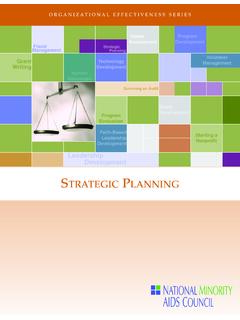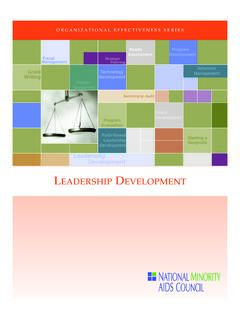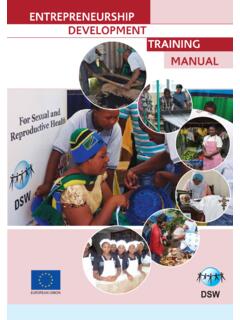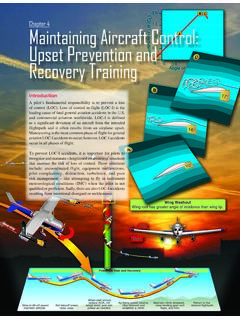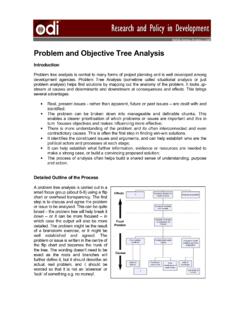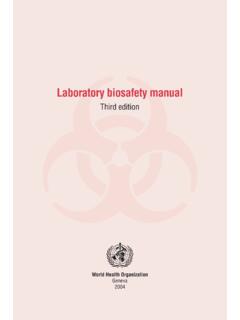Transcription of ORGANIZATIONAL EFFECTIVENESS SERIES
1 Faith-BasedLeadership DevelopmentStrategicPlanningVolunteer ManagementTechnologyDevelopmentProgramDe velopmentLeadership DevelopmentFiscalManagementSurviving an Audit HumanResourcesProgram EvaluationGrant WritingStarting a NonprofitBoard DevelopmentNeeds AssessmentORGANIZATIONAL EFFECTIVENESS SERIESPROGRAMDEVELOPMENT81938_NMAC_cvr 8/29/03 4:02 PM Page 1 Dear Colleague,On behalf of the National Minority AIDS Council (NMAC), thank you for picking up this manual and taking a step toward increasing your capacity in this struggle. As we enter thethird decade of HIV/AIDS, it is more important than ever to develop our skills and knowl-edge to better serve our communities and our , established in 1987 as the premier national organization dedicated to developingleadership within communities of color to address the challenge of HIV/AIDS, recognizesthe challenge before all of us and works to proactively produce and provide skills-buildingtools to our community.
2 One such tool is the manual that you hold in your Technical Assistance and training Division s mission to build the capacity and strengthof community-based organizations, community-planning groups for HIV prevention, andhealth departments throughout the United States and its territories is supported through amultifaceted approach. This approach includes individualized capacity-building assistance,written information (manuals, publications, and information provided through NMAC s web-site and broadcast e-mail messages and interactive learning experiences (trainings). All com-ponents are integral to providing a comprehensive capacity-building assistance experience,as opposed to offering isolated instances or random episodes of undergoing a revision of existing curricula and publications, and an expansion of ourcurrent catalog of subject areas to include more organization infrastructure topics, NMAC is proud to present you with this new manual, Program Development.)
3 One of 15 topic areasin which we provide capacity-building assistance, this manual will provide you with detailedinformation, resources and the knowledge to enhance your capacity to provide much-needed services in your hope is that this revised manual will give you the skills and knowledge to increase yourcapacity and serve your community at a greater level than ever before. Please feel free tocontact us if you would like further information on what other services we can provide to you and your in the struggle,Paul Akio KawataExecutive 8/29/03 3:56 PM Page 13 ContentsPreface ..5 Introduction ..7 UNIT 1: Introduction .. Is Program Development? ..13II. Program Development Pre-test ..14 III. Why Is Program Development Important? ..15IV. Content of the Program Plan ..15V. The Planning Process.
4 16VI. Program Development: The Seven-Step Model ..17 UNIT 2: The Needs Assessment .. Is a Needs Assessment? ..21II. Steps in Assessing Needs ..21 III. Suggestions for Developing a Questionnaire ..26IV. Researching Existing Programs ..27 UNIT 3: Developing Mission, Goals and Objectives .. Mission Statement ..33II. Setting Goals ..35 III. Developing Objectives ..37 UNIT 4: Identifying Funding Sources .. Sources ..41II. Community Fund-Raising ..41 III. Foundation Resources ..43IV. Government Sources ..45 UNIT 5: Assigning Leadership Tasks .. that Influence Good Leadership ..52II. Create a Program Planning Team ..55 III. Program Planning Team Roster ..5581938_NMAC blcx 9/3/03 3:21 PM Page 3 UNIT 6: Program Design .. Action Plan ..61II. Program Design Planning ..62 III. Intervention Activities Timeline.
5 64IV. Collaboration and Coordination ..65V. Evaluation Plan ..66VI. Staffing Plan ..67 VII. Budget ..68 UNIT 7: Program Implementation .. Implementation ..75 UNIT 8: Evaluation .. Evaluations ..82II. Helpful Tools ..86 Appendix A: Glossary ..93 Appendix B: Frequently Asked Questions ..97 Appendix C: Bibliography .. 8/29/03 3:56 PM Page 4 PrefaceOrganizational EffectivenessSuccessful community-based organizations (CBOs) can attribute their success to employing 15 key components that support ORGANIZATIONAL EFFECTIVENESS . See themodel below. Ongoing learning and training in each of these areas will allow your organization tomeet the needs of your information regarding training in any of these areas, contact the National MinorityAIDS Council s Technical Assistance, training and Treatment Division by telephone at (202) 234-5120 or by e-mail at EFFECTIVENESS MODELO rganizationalOrganizationalEffectiveness EffectivenessStrategic PlanningLeadership DevelopmentBoard DevelopmentHuman ResourcesProgram DevelopmentFiscal ManagementSurviving an AuditHIV Prevention Community PlanningProgram EvaluationNeeds AssessmentVolunteer ManagementStarting a NonprofitTechnology DevelopmentGrant WritingFaith-Based Leadership 8/29/03 3.
6 56 PM Page 5 IntroductionPurposeQuality program development must be supported by a well-thought-out and documented plan of action. The purpose of this manual is to provide a step-by-step outline of the planning process that communities, groups and organizationsshould follow to develop action plans and successful ObjectivesUpon completion of this manual, learners should be able to: Identify the steps and explain the importance of program development. Explain why program planning is essential to program development. Describe how knowledge of program development can support community organization design and prevention program implementation. Explain what a needs assessment determines and how the information it generates can be used in program planning. Describe what should be included in a needs assessment. Explain the steps for conducting a needs assessment and describe how this information will be applied in the context of an organization.
7 Identify who can conduct a needs assessment and prepare a list of possible recommendations. Explain ways that a program assessment is useful and describe how the assessment can enhance service delivery. Develop a needs assessment questionnaire. Explain why mission statements are essential. Write an effective mission statement. Explain why program goals are necessary. Explain how to write realistic, time-framed and measurable goals. Write realistic, time-framed and measurable goals. Write attainable program objectives. Identify the major sources of funding. Identify ways to develop and improve relationships with funding agencies. Explain why assigning leadership roles is an essential step in building successful programs. Understand the different leadership styles and identify styles that support your organization s DEVELOPMENTAn ongoing, compre-hensive planning pro-cess used to establishprograms supported bya well-thought-out and-documented plan IMPLEMENTATIONThe stage in programplanning where you develop procedures for carrying out blcx 9/3/03 3:21 PM Page 78 Identify factors that influence good leadership and design activities for implementingleadership-development training and group maintenance roles.
8 List the characteristics of a good leader. Explain the relationship between successful programs and competent leadership. Explain why program design is integral to overall program planning. Explain the major components of an action plan. Describe your interventions, outline the services that comprise your interventions and present the activities you will engage in to implement the interventions. Describe how your interventions will be implemented and by whom. Explain the importance of program implementation and outline an implementation plan for a program. Identify the elements of program design necessary to ensure the successful imple-mentation of program activities, and explain why they are important. Explain program evaluation and describe how it is useful for making programmatic decisions in a program. Describe the purpose of conducting evaluations and explain how each purpose can impact a program.
9 Explain impact assessment and identify which areas you would like to have an impact on AIDS/HIV prevention and other sexually transmitted disease-prevention 8/29/03 3:56 PM Page 8 Pre- training AssessmentThis Pre- training Assessment is an opportunity for you to check your knowledge against theinformation that will be addressed in this manual. Take this test now and again when youhave finished the manual. Answers are found on page AssessmentPlease circle the following statements either True or first step in planning a needs assessment is to decide who will conduct the needs assessment identifies the extent and type of existing problems in your community and the services consultants are the only ones capable of performing a needs data on historical development helps you understand your community s growth patterns and population data includes information such as age, character-istics, size.
10 And needs assessment determines whether resources are the responsibilities in creative ways may help in performing a cost-effective needs of the disadvantages in using volunteers to help with needs assessments is that they may present a biased inter-pretation of what the community profile of the population you intend to serve should be included in the needs needs assessment is an essential part of the planning process when designing successful community blcx 9/3/03 3:21 PM Page 9 Purpose:This unit explains program development as an ongoing comprehensive planning process used to establish Objectives:By the end of this unit, learners will be able to: Explain the importance of program development. Explain why program planning is essential to program development. Describe how knowledge of program development can support community organization design and help implement prevention programs.

